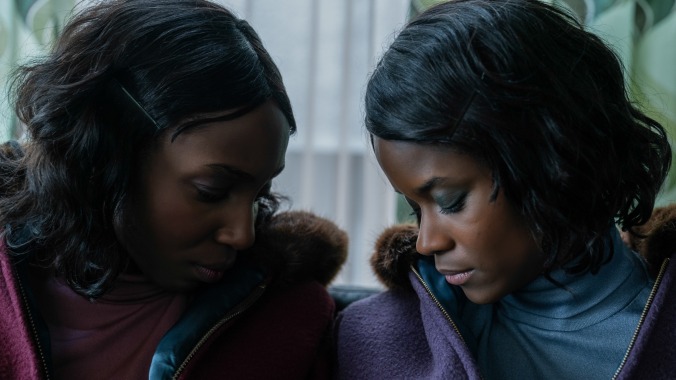In The Silent Twins, Letitia Wright and Tamara Lawrance struggle to give real-life sisters a voice
Their unusual story is faithfully chronicled, which unfortunately leads into the "white savior" trope

The Silent Twins opens with the voices of two young girls. They narrate the credits with inviting, peppy animation, reading the actors’ names and laughing at their own. The joy in their voices contrasts with the film’s title, offering an appealing way to welcome viewers into the story. Unfortunately, the remainder of the almost two-hour running time settles into a more somber and mournful tone, with only a little bit of humor and uplift.
The film, directed by Agnieszka Smoczynska and written by Andrea Seigel, tells the true story of twin sisters who only communicate with each other while remaining silent to the rest of the world—including their parents and other sister. Jennifer (played by Tamara Lawrance as an adult and Eva-Arianna Baxter as a child) and June Gibbons (Letitia Wright as an adult and Leah Mondesir-Simmonds as a child) are born in 1963 in Wales to parents who immigrated from Barbados. They weren’t always silent, but started to speak less and less when they turned 8. They escape to their own world, creating a language that they alone share while making dolls and stuffed toys for elaborate plays. Confounding everyone around them, Jennifer and June are sent to a special school and treated by a child psychologist, but they continue to be silent, living in their own world.
A few years older and no longer at school, Jennifer and June are more isolated than ever. But the plays they write lead to writing stories that get June published. Nevertheless curious about sex and drugs, they take up with an American boy (Jack Bandeira) who lives in their neighborhood. They both lose their virginity to him, leading to jealousy, and eventually, physical fights.
As June and Jennifer become fully fleshed out characters beyond their silent affliction—finally becoming women with desire and sensuality—they develop varied interests and take charge of their lives. In addition to the meticulous period detail in costumes and sets, Smoczynska films their flights into fantasy with real flair. The screen is full of indelible colorful images that please the eye. A soundtrack of recognizable 1970s and ’80s pop hits adds an enjoyable wave of nostalgia.
However, this moment passes for them quickly. The sisters soon fall into a life of petty crime, and are subsequently held in a psychiatric hospital. As a result, the film loses all the visual ingenuity that makes it unique. The saving grace is Lawrance, who gives Jennifer a potent mix of fire and solemnity, and emphasizes her complexity despite the broad strokes of the script. She’s jealous of her sister’s writing talent, yet loves her fiercely; Lawrance registers these conflicted emotions to imbue her character with more pathos than being just a victim of the system. Wright amiably shares the screen with Lawrance, yet her portrayal remains aloof, never giving us any real insight into what makes June tick. The fault lies primarily with the script, which does not allow for a deeper portrayal of these women beyond their affliction.
The film especially falters once British journalist Marjorie Wallace (Johdi May) enters. While it’s based on her book about the Gibbons sisters, May’s portrayal makes her a stereotypical “white savior” too familiar in many films about Black people. After the sisters are institutionalized, their parents vanish from the film. Wallace seems like the only person who cares enough about their well-being to do something about it. While she stops short of actually saving them, she’s basically “the concerned white.” That, coupled with the sometimes opaque ways in which the sisters are depicted, makes this part of the story less engaging. It’s the more familiar and uninteresting territory of the state victimizing its Black citizens: while it may be true to the Gibbons’ story, the film’s initial flair completely disappears in the third act.
The tragic story of two women whose talents were never allowed the space to shine had real potential to resonate. But in The Silent Twins, the Gibbons sisters are let down by a script that undercuts the unique circumstances of their lives with familiar and ultimately less compelling storytelling tropes. If only Smoczynska could have remembered the vividness of those young girls’ voices from that unique opening when she made the rest of the film.